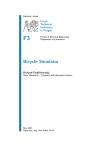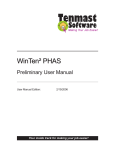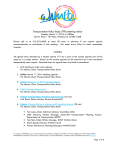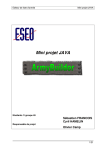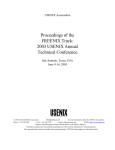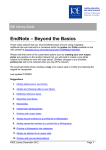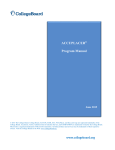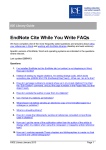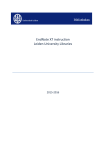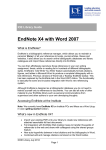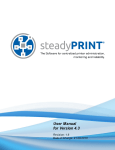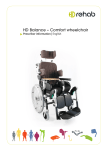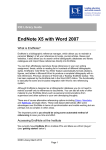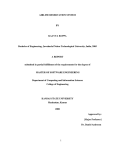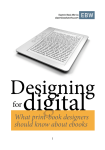Download Faculty User`s Manual
Transcript
WILLIAM H. HANNON LIBRARY Lion’s Guide to Research & the Library: First Year Seminar Information Literacy Tutorial 2015-16 Faculty User’s Manual Table of Contents LION’S GUIDE TO RESEARCH & THE LIBRARY ......................................................................1 TUTORIAL CONTENT ...............................................................................................................1 Tutorial Content Overview ................................................................................................................................. 1 Point Values ............................................................................................................................................................. 1 Learning Outcomes ............................................................................................................................................ 2 Key Points ................................................................................................................................................................ 3 Detailed Content Outline ..................................................................................................................................... 3 Quiz Content ........................................................................................................................................................... 7 USING THE TUTORIAL IN MYLMU CONNECT (BLACKBOARD) ............................................7 Locating the Tutorial in MyLMU Connect ............................................................................................... 8 Preparing Your Course Site ................................................................................................................................ 8 Default Settings and Customizations ....................................................................................................... 9 USING THE GRADE CENTER IN MYLMU CONNECT (BLACKBOARD) ................................. 12 Reading the Grade Center................................................................................................................................ 12 Modifying the Grade Center ............................................................................................................................ 13 Manually Entering Grades............................................................................................................................... 17 Export the Grade Center to Excel .................................................................................................................. 18 TROUBLESHOOTING TECHNOLOGY ..................................................................................... 18 Technology Requirements ........................................................................................................................... 19 Technology Troubleshooting ..................................................................................................................... 19 INCORPORATING THE TUTORIAL INTO COURSE CONTENT.............................................. 21 Sample Syllabus Text ..................................................................................................................................... 21 Discussion Topics ............................................................................................................................................. 22 Sample Assignments....................................................................................................................................... 25 APPENDIX A – KEY POINTS ................................................................................................... 26 APPENDIX B – ASSIGNMENTS ............................................................................................... 31 CONTACT INFORMATION ...................................................................................................... 38 LION’S GUIDE TO RESEARCH & THE LIBRARY F irst Year Seminar (FYS)courses are required to ―assign at least 10% of the course grade on the basis of assessed information literacy, which must include completion of standardized tutorials prepared by LMU librarians‖ (http://www.lmu.edu/Assets/First+Year+Seminar.pdf). This document has been created for FYS faculty as a guide to using the tutorial. TUTORIAL CONTENT This section will cover the following items: Tutorial Content Overview Point Values Learning Outcomes Key Points Detailed Content Outline Quiz Content Tutorial Content Overview Lion’s Guide to Research and the Library is a collection of 10 online learning objects organized into 5 sections. Each section contains one module and one quiz. The sections are as follows: Section A: STARTING YOUR ASSIGNMENT Section B: TYPES OF INFORMATION Section C: FINDING BOOKS Section D: FINDING ARTICLES Section E: USING INFORMATION ETHICALLY Point Values LION’S GUIDE TO RESEARCH & THE LIBRARY IS WORTH A TOTAL OF 500 POINTS In total, the tutorial is worth 500 points. The point breakdown for each section is as follows: Section A: Starting Your Assignment Starting Your Assignment Module: 70pts Starting Your Assignment Quiz: 30 pts Section B: Types of Information Types of Information Module: 70pts Types of Information Quiz: 30 pts 1 Section C: Finding Books Finding Books Module: 70pts Finding Books Quiz: 30 pts Section D: Finding Articles Finding Articles Module: 70pts Finding Articles Quiz: 30 pts Section E: Using Information Ethically Using Information Ethically Module: 70pts Using Information Ethically Quiz: 30 pts Learning Outcomes Each section of the tutorial has a specific set of learning outcomes. They are as follows: Section A: STARTING YOUR ASSIGNMENT Upon completing this module, student will be able to: Understand that scholarly research is a conversation among scholars and experts. Select a balanced research topic. Identify key concepts and keywords in your research topic. Find and use credible background information. Section B: TYPES OF INFORMATION Upon completing this module, student will be able to: Identify the appropriate type of information based on your information need. Understand how information is produced. Differentiate between primary, secondary & tertiary sources. Understand the difference between scholarly, popular, and trade information sources. Section C: FINDING BOOKS Upon completing this module, student will be able to: Identify key places to search for books. Understand the organization of books in the library in order to locate a book in the library. Construct an appropriate search strategy in the library catalog. Section D: Finding Articles Upon completing this module, student will be able to: Identify key places to search for articles. Understand how to read an article record in a research database in order to predict its usefulness. 2 Construct an appropriate search strategy in a research database to find articles. Section E: USING INFORMATION ETHICALLY Upon completing this module, student will be able to: Understand what constitutes plagiarism in order to acknowledge the work of others. Understand what constitutes a copyright violation. Differentiate between book citations and article citations. Identify the citation elements for books and articles. Key Points Each section of the tutorial has a link to a collection of ―Key Points‖ that students may print out. The key points can be found online: Starting Your Assignment: http://libguides.lmu.edu/startingyourassignment Types of Information: http://libguides.lmu.edu/typesofinfo Finding Books: http://libguides.lmu.edu/findingbooks Finding Articles: http://libguides.lmu.edu/findingarticles Using Information Ethically: http://libguides.lmu.edu/usinginformationethically Detailed Content Outline Section A: Starting Your Research Assignment Topics: introduction to college-level research and scholarly communication; choosing a balanced topic; identifying the key concepts in a research question and compiling a list of keywords; identifying an ―information need‖ and finding background information. Detailed Description: Introducing College-Level Research This section introduces the student to the purpose and expectations of collegelevel research. It explains that research is a way of tapping into the scholarly communication network and shows that the scholarly resources they are asked to use in their research assignments represent the way scholars present their ideas to their peers. The concept of ―audience‖ is also explained. Choosing a Topic This section explains how to select a well-balanced topic. The interactive text demonstrates how identifying the ―who, what, where, when, why, and how‖ of a particular topic can help narrow down its focus. It emphasizes the importance of picking a topic that is not too broad and not too narrow and shows how a topic can be approached from multiple discipline-specific perspectives. An interactive exercise then asks the student to identify balanced and imbalanced examples of research topics. 3 Selecting Keywords This section explains the importance and value of identifying the key concepts of a research question and helps students begin to understand how to create a list of keywords from which they can begin their database and library searches. It explains the concept of ―natural language‖ and shows the differences in results when using key phrases or whole sentence structure in a search engine. An exercise then asks the student to select the key concepts from sample research questions and then demonstrates how to narrow or broaden these key concepts. Following this, the importance of synonyms in research is explained and reinforced through several interactive exercises. Using Background Information This section covers identifying an ―information need‖ and then locating and using credible background information. A short video explains the concept of finding background information and is followed by examples of subjectspecific encyclopedias that can be found in the library’s resources. This section also touches on the use of Wikipedia for college-level research. The student learns about using cited works or ―further reading‖ sections from encyclopedias to find more sources. Section B: Types of Information Topics: information types; how information is produced and the timeline of information production; what makes information ―scholarly‖; scholarly, popular, and trade sources; peer review process; primary, secondary, and tertiary sources. Detailed Description: Types of Information This section introduces students to the common types of information resources available to them, including news, entertainment/popular, scholarly, opinion, and professional/trade. Information types are not inherently good or bad, but their utility will depend on your information need (e.g. timeliness or degree of research needed). For example, the tutorial demonstrates how a researcher looking for information on a very current event would use a news source rather than a scholarly source. Blogs, tweets, and other social media are mentioned briefly as well. Producing Information To help the student understand what type of information will be available, this section presents the timeline for information production. Using the 2008 election as an example, the section shows the kinds of information that is published and when: minutes (news, etc. – basic facts); hours (news, etc. – basic facts and public opinion), days (continued news/reporting - expert opinions); weeks (continued news reporting, magazine features – analysis of event begins in earnest); months (research – scholarly articles begin to circulate); years (more research – books begin to be published); more years 4 (treatment of event in tertiary sources). The student is then asked to put a list of information sources from a sample event into the correct order of publication. What Makes Information “Scholarly”? (Scholarly, Popular, and Trade Sources) This section introduces the differences between scholarly, popular, and trade publications by showing example publications from several disciplines. It discusses what is featured in each type of publication, who writes the content, who reads the publications, and what the content looks like. It then discusses the advantages and disadvantages of each type of publication. The student is then asked to determine the type of publication for some example articles (a citation and abstract are provided.) Peer Review Process The process of peer review is introduced in this section. In an interactive exercise, the student is asked to put the steps of the peer review process in order. Primary, Secondary, and Tertiary Sources This section defines primary, secondary, and tertiary sources. For each type of source, a multidisciplinary definition, a list of characteristics and a list of examples are given. In an interactive exercise, the student is given an example research question and a list of sources and must decide whether each source is primary, secondary, or tertiary. Section C: Finding Books Topics: where to look for books; introduction to the library website; using the library catalog to search for books owned by LMU; introduction to the Library of Congress Classification System; finding the physical location of a book in the library. Detailed Description: Where to Look for Books This section introduces students to the search tools available to them to find books for their research assignments. It explains the difference between finding a book through the library versus finding a book through the open web. The Library Website This section provides a basic orientation to the Library website and an introduction to the Get Help page, which contains the library’s FAQ’s and the option to chat with a librarian to get help. Searching for Books in the Catalog This section explains the student can find books owned by LMU by searching in the library catalog (LINUS). It also takes the student on a 5 ―guided search‖ in LINUS. During the guided search, search strategies are introduced and important information from a catalog record is highlighted. Finding Books in the Library This section presents a brief description of how the books in the library are organized, with an overview of the Library of Congress Classification System. It explains how to use call numbers to get the books found in a catalog search in hand. Section D: Finding Articles Topics: where to find articles; an advanced introduction to using the library’s website to find articles; using research databases to find scholarly journal articles. Detailed Description: Where to Look for Articles This section introduces students to the search tools available to them to find articles for their research assignments. It explains the difference between finding articles through the library versus finding articles through the open web. The Library Website This section provides a more advanced orientation to the Library website as a portal for finding articles. The Research Databases page, Journal List, and LibGuides are introduced and explained. Using Research Databases This section will take the student on a ―guided search‖ in the Proquest Research Library research database. This database has a broad, multidisciplinary scope and a user-friendly interface. The guided search will present search strategies, show how to limit search results to ―peer reviewed,‖ and point out other helpful features the database provides such as emailing an article and finding the full-text of an article. Finally, it will explain the common fields in an article record such as abstract and source. Section E: Using Information Ethically Topics: plagiarism, copyright, and academic integrity; the LMU Honor Code; avoiding unintentional plagiarism; understanding and reading citations; constructing citations; and identifying different citation styles (MLA, APA, CSE, Chicago). Detailed Description: Understanding Plagiarism This section discusses plagiarism and academic integrity in depth. It gives examples of famous cases of plagiarism (George Harrison, Jonah Lehrer, and 6 Kaavya Viswanathan). This section also introduces the ten most common forms of plagiarism found in secondary and higher education and the level of seriousness of each one. The LMU Honor Code and the consequences for violating the Honor Code are presented. It is reinforced that the consequences for plagiarism are generally at the discretion of the individual faculty member or instructor and that it is the student’s responsibility to understand a professor’s policy on plagiarism for each course. Copyright is also introduced in this section. Avoiding Plagiarism This section discusses strategies the student can employ for avoiding unintentional plagiarism. It discusses how to paraphrase and summarize and how to use quotations. It also touches on procrastination and how leaving a research assignment until the last minute greatly increases the student’s chance of unintentionally plagiarizing. Understanding and Reading Citations This section introduces students to the concept of ―bibliographic information‖ and the basic anatomy of a citation. In this section, the student is asked to look at citations from various information sources (book, journal article, book chapter) and pick out the various pieces of bibliographic information necessary for a complete citation. It also asks the student to identify the type of source simply by looking at the citation. Constructing Citations The final section of the tutorial is a basic introduction to constructing citations. It covers four different discipline-specific citation styles: MLA, APA, CSE, and Chicago. The bibliographic information needed to construct citations is reinforced. This section also points to multiple outside sources the student can consult when constructing citations, such as the Writing LibGuide and Purdue OWL (Online Writing Lab). Quiz Content The questions and answers for each quiz can be found in the FYS course site in MyLMU Connect. They are located in a folder titled ―Faculty Resources: Information Literacy Tutorial.‖ This folder is hidden to students. It is not recommended that you give printouts of these to students, but go over the answers verbally in class. All freshmen are completing the same quizzes. USING THE TUTORIAL IN MYLMU CONNECT (BLACKBOARD) This section will cover the following items: Locating the tutorial in MyLMU Connect Preparing Your Course Site Default Settings and Customizations 7 Locating the Tutorial in MyLMU Connect The online modules and quizzes that make up the tutorial are located in all FYS course sites in MyLMU Connect (Blackboard), the campus’ Learning Management System. MyLMU Connect can be accessed after logging in to my.lmu.edu under ―System Logins‖ (See Figure 1). The tutorial modules and quizzes are loaded into each FYS course before the semester begins. All of the modules and quizzes that make up the full tutorial can be found in a folder titled ―Information Literacy‖ in each FYS course site (See Figure 2). Preparing Your Course Site STUDENTS WILL NOT SEE THE COURSE SITE WHEN THEY LOGIN TO MYLMUCONNECT IF IT IS NOT MADE “AVAILABLE” Figure 1 – my.lmu.edu Figure 2 – MyLMU Connect course site menu Before the start of the semester, the ITS Department will push out the FYS course site templates to all FYS faculty through MyLMU Connect (Blackboard). The FYS course site templates will have the most recent versions of the tutorial modules and quizzes set up within the course. It is recommended that faculty use the latest course templates rather than copying an older FYS course. This ensures that the students are using the most up-to-date tutorial modules. Using the most up-to-date tutorial modules will ensure that any technical issues can be handled accurately and timely. The only step faculty must take to make their course visible to their students is to set it to ―Available‖ in MyLMU Connect. To make the FYS course site visible to enrolled students, follow the following steps: 1. Login to MYLMU Connect 2. Open your FYS course site 3. Under ―Control Panel‖, click ―Customization‖ 4. Click ―Properties‖ 8 5. In section 3, Make Course Available, select ―Yes‖ 6. In section 4, ―Course Duration‖, choose the dates of the course availability 7. Click ―Submit‖ to save your changes Default Settings and Customizations Default Settings Modules: All of the modules and quizzes are accessible to students for the entire semester. Students are allowed to take each module twice. If they elect to take a module a second time, the second grade will override the first in the grade book. Quizzes Students are allowed to take each quiz once. Students do not receive feedback on the correct answers. Customizations To make customizations to the quizzes or modules, make sure the ―Edit Mode‖ is turned on. If it is off, click on ―off‖ to enable edit mode (See Figure 3). Figure 3 Modules: Faculty can adjust the default setting to make the modules only accessible to students the week that they are due by using the ―Adaptive Release‖ feature. Instructions: 1. Navigate to the module in the Information Literacy Folder. Click the small arrow next to the title and select ―Adaptive Release‖ from the menu (See Figure 4). 9 Figure 4: Customization menu for modules 2. Navigate to ―SCORM Availability,‖ enter the date range and click ―Submit‖ to save (See Figure 5). Figure 5: Adaptive Release Faculty can adjust the number of times students can complete a module and which grade is recorded into the Grade Center. Instructions: 1. Navigate to the module in the Information Literacy Folder. Click the small arrow next to the title and select ―Edit‖ from the menu (See Figure 6). 10 Figure 6: Customization Menu for Modules 2. Navigate to ―SCORM Availability,‖ adjust number of attempts, and click ―Submit‖ to save (See Figure 7). Figure 7: Number of Attempts 11 Using the Grade Center in MyLMU Connect (Blackboard) This section will cover: Reading the Grade Center Modifying the Grade Center Manually Entering Grades Exporting Grade Center to Excel When students complete a module or quiz, the grade they earned will be automatically recorded in the MyLMU Connect course site’s Grade Center. To find the Grade Center navigate to the ―Course Management‖ menu and select ―Full Grade Center‖ (Figure 8). Additionally, students have the option of printing a ―Certificate of Completion‖ for each module and giving it to the faculty member or writing instructor. Figure 8 Reading the Grade Center The Grade Center includes individual columns (10 in total) for each component of the tutorial. The ―Total‖ column will display the cumulative percent grade earned across all 10 tutorial components. Figure 9 – Reading the Grade Center in MyLMU Connect 12 Modifying the Grade Center There may be situations where you will want to modify the Grade Center. If faculty elect to use the Grade Center for other items in addition to the information literacy modules and quizzes, it may be useful to create a column in the grade center that totals ONLY the information literacy items. Creating “Information Literacy Total” Column in the Grade Center 1. Navigate to the Grade Center in MyLMU Connect 2. Select ―Create a Calculated Column‖ and choose ―Total Column‖ (Figure 10) Figure 10 3. Name the new column (See Figure 11) Figure 11 4. Choose ―Selected Columns and Categories‖ then highlight and move the information literacy items into the ―Selected Columns‖ window (See Figure 12) 13 Figure 12 5. Click ―Submit‖ to save. 6. The new ―Information Literacy Column will appear as the very last column in your Grade Center (See Figure 13) Figure13 7. To rearrange the Grade Center columns to make the new total column more visible, select ―manage‖ and then ―Column Organization‖ from the dropdown menu (See Figure 14) 14 Figure 14 8. Use your mouse to drag and drop the new column to the place where you would like it to appear in the Grade Center (See Figure 15) Figure 15 9. Click ―Submit‖ to save. Change Grade Display to Point Value The Grade Center currently displays the grades received on the information literacy modules and quizzes as percentages. If it is preferable to view the grades as point values follow the steps below: 1. Navigate to the Grade Center Column that needs to be changed and select ―Edit Column Information‖ from the drop-down menu (See Figure 16) 15 Figure 16 2. In the ―Primary Display‖ section, select ―Score‖ from the drop-down menu (See Figure 17) Figure 17 3. Click Submit to save. This process will have to be repeated with all Grade Center Columns. 16 Manually Entering Grades If a student’s grade for a module or quiz is not properly recorded, faculty can manually enter the student’s grade into the Grade Center. All students that complete a section of the tutorial are prompted to print a ―Certificate of Completion‖ at the end of each module and a screenshot of their quiz results to prove that they have completed that tutorial section. Check for Proof of Completion Modules Students are prompted to print out a ―Certificate of Completion‖ when they finish each module (Figure 18). This certificate includes the day the module was completed and their grade percent. Students should present this certificate before a grade is manually entered in the Grade Center. Figure 18: Certificate of Completion Quizzes Students are asked to take a screenshot of their quiz results and save them for their records (Figure 19). Students should present this screenshot before a grade for that quiz is manually entered into the Grade Center. Figure 19 17 Manually Entering Grades To manually enter a grade for a student, double click the cell in the Grade Center that should contain the grade and type in the percent score and click enter. When a score has been manually entered, a small yellow arrow will appear in the corner of the cell (Figure 20). Figure 20 Export the Grade Center to Excel Faculty are not required to use the MyLMU Connect Grade Center for their grades in FYS courses. If the Grade Center in MyLMU Connect is not the preferred method of recording grades, faculty can export the grade center into an Excel spreadsheet by navigating to the Grade Center and selecting ―Download‖ from the ―Work Offline‖ drop-down menu (See Figure 21). As an alternative, faculty may contact Lindsey McLean, the Instructional Design Librarian, at [email protected] to have the information literacy grades for the class emailed as an Excel spreadsheet. Figure 21 Troubleshooting Technology This section will cover the following: Technology Requirements 18 Technology Troubleshooting Technology Requirements The tutorial has the following technical requirements. Students are presented with these requirements at the start of each module. Browser: Preferred - Firefox Acceptable - Safari and Internet Explorer Discouraged: Google Chrome (the tutorial will freeze on students using Google Chrome. Please advise students to avoid this browser when completing the tutorial.) Plugins The following plugins must be up-to-date before completing the tutorial. Current plugins help the tutorial function and protect a student’s computer while they are browsing the web. Java – update or download here: http://java.com/en/download/installed.jsp?detect=jre&try=1 Adobe Flash – update or download here: http://get.adobe.com/flashplayer/ Network The tutorial requires a stable Internet connection. It is recommended that they complete the modules using an LMU wireless or wired network. Hardware Students should use a desktop or laptop computer to complete the tutorial. Students should not use tablets or smartphones to complete the tutorial. If they do attempt to use a smartphone or tablet, the tutorial will not work properly and their grade will not be recorded. Technology Troubleshooting Some students will run into technical issues because they have not read or understood the technical requirements. The following is a list of the common issues that may confront students and how faculty can respond: COMPLAINT: I clicked on the module but nothing happened/it didn’t open! SOLUTION: The modules are designed to open in a new window. The window may have opened up behind the window they are currently looking at. Advise students to view all of their open browser windows. 19 SOME STUDENTS WILL RUN INTO TECHNICAL ISSUES BECAUSE THEY HAVE NOT READ OR UNDERSTOOD THE TECHNICAL REQUIREMENTS. If the student’s pop-up blocker is activated, this may stop the module from opening. Have students deactivate their pop-up blocker*. If they are using Firefox (as directed) they will be given a message that the module did not open due to the pop-up blocker and prompted to launch the course. *to disable pop-up in Firefox: navigate to the Menu, select ―Options‖, navigate to ―Content‖ and either uncheck the box next to ―Block pop-up windows‖ or add mylmuconnect.lmu.edu as an exception. COMPLAINT: The tutorial froze and I couldn’t finish it! SOLUTION: Make sure that the student has followed the technical requirements. Students have to have updated Java and Flash Player Plugins on the computer they use AND you have to take the tutorial using Firefox. The tutorial will freeze if you use Google Chrome. After the student has updated their plugins, they will need to clear their cache on their browser before attempting the tutorial again*. If all else fails, the student can complete the tutorial on the computers in the library. The library is open 24 hours, 5 days a week. *to clear the cache in Firefox navigate to the Menu, select ―Options‖ then navigate to ―Advanced.‖ On the Advanced page, select the ―Network‖ tab and click ―Clear Now‖ in the ―Cached Web Content‖ section of the page. COMPLAINT: The module crashed in the middle! Will that count as one attempt even though I didn’t finish? SOLUTION: The system will count an attempt only when the student has completed the entire tutorial and submitted their grade. If the module crashes in the middle the student should log in again and resume from where they left off. If this happens, the student should make sure they are on a stable Internet connection before resuming the module. COMPLAINT: My grade wasn’t recorded in the grade book! SOLUTION: Students have the ability to print out a certificate of completion for each module that has their name, the date they completed the modules and their grade. This option is on the very last slide of each module. COMPLAINT: The module said I got a question wrong, but I didn’t! SOLUTION: 20 The modules have been tested thoroughly and all of the scoring functions work properly. If a student feels they were scored incorrectly due to a technical issue, there is detailed data available about how they answered each question in the module in MyLMU Connect. You may contact Lindsey McLean ([email protected]) for directions on how to obtain this information. COMPLAINT: I don’t know which answers I got wrong on the quiz/ why can’t I see the correct answer if I get a question wrong on the quiz? SOLUTION: Faculty and writing instructors have access to a folder called ―Information Literacy Quiz Questions & Answers‖ in their MyLMU Connect course site. These are available in case students want to go over the correct answers. We would prefer to give students immediate feedback in the quiz, but because all of the freshmen are completing the same quizzes, we need to discourage dishonest behavior by keeping the answers in a secure environment accessible to faculty and writing instructors only. COMPLAINT: the Library catalog/research database isn’t loading in the module and I can’t complete the questions SOLUTION: All of the slides that include a guided search in either the library catalog or research database have links to open the appropriate URL in a new window. Students can use this option if they find the search pages in the database or library catalog are not working properly. Incorporating the tutorial into course content This section will cover the following: Sample Syllabus Text Discussion Topics Sample Assignments Sample Syllabus Text Please feel free to use some or all of the following language in your course syllabus: Information Literacy Information Literacy entails the ability to locate, evaluate, and use information effectively and ethically, developing the critical thinking skills that form the basis of lifelong learning. We will be spending some time in the course on information literacy as it relates to writing and the study of ___________. Information Literacy Learning Outcomes for FYS 21 Be able to evaluate sources for quality (e.g., by learning to differentiate between scholarly and popular sources) Acquire research skills including use of the library catalog and electronic databases to retrieve books or articles, whether in print or online Information Literacy Tutorial During the course of the term students are required to work through the Lion’s Guide to Research & the Library tutorial. The tutorial is made up of five sections, with each section containing one module and one quiz. All of the modules and quizzes are accessible through MyLMU Connect. In each section, the module can be taken twice while the quiz can only be taken once. If a student elects to take the module twice, the second grade will be the one counted toward the final grade. Each section of the tutorial (module and quiz) needs to be completed by the following due dates: 1. Starting Your Research Assignment (module & quiz) - complete by X/X/2014 (e.g. 9/5/2014) 2. Types of Information (module & quiz) - complete by X/X/2014 (e.g. 9/19/2014) 3. Finding Books (module & quiz) - complete by X/X/2014 (e.g. 10/3/2014) 4. Finding Articles (module & quiz) - complete by X/X/2014 (e.g. 10/17/14) 5. Using Information Ethically (module & quiz) - complete by X/X/2014 (e.g. 10/31/14) The modules may be found through MyLMU. Just follow these steps: Login to MyLMU Connect at http://mylmuconnect.lmu.edu Click on the course title (________) to enter the course page. Click on the ―Information Literacy‖ link in the course menu on the left-hand side of the page. Click the link for the Information Literacy tutorial Module you have been assigned. The tutorial will open in a new window. The Library has created a FFYS 1000 LibGuide to further assist students with the content and key concepts in the tutorial. It is located at http://libguides.lmu.edu/ffys1000 Grading: Information Literacy Tutorial & Quizzes - 10% Discussion Topics To help students understand the themes in each tutorial module, consider starting a discussion using any of the following. Time the discussion to coincide with the due date of the module where the theme is covered. 22 Starting Your Assignment Module Theme: Scholarship is a Conversation Begin by asking how students find information. Do they use Google? The library? Twitter? Then describe how you and/or your colleagues do research, emphasizing any professional organizations you are affiliated with and the type of literature you typically read. The purpose of this discussion is to articulate the scholarly process by emphasizing how scholars communicate ideas with each other. Theme: Scholarship is a Conversation Alternatively, have the writing instructor interview a FYS faculty member and ask him/her to describe how they do research, how research gets disseminated in their field, etc. Students should be encouraged to ask their own questions. THEME: SCHOLARSHIP IS A CONVERSATION Theme: Understanding the Research Process Have students reflect upon the steps they went through when researching a major purchase or event in their lives (buying a car, selecting a college, etc.). Then identify the steps involved in the research behind such a decision, and confront the importance of employing a similar strategy in the academic setting. Theme: Find and Use Credible Background Information Find a Wikipedia article on a topic relevant to the course and a related article in a published reference or academic database. Invite the students to compare and contrast the two. For extra credit, you can ask for volunteers to improve the Wikipedia article by using better sources. Theme: Identify Key Concepts and Keywords in Your Research Topic Pick a research paper topic and invite your students to help you come up with keywords. Types of Information Module Theme: Identifying the Appropriate Type of Information Based on Information Need Start a discussion with your class about what the appropriate information sources are for your discipline. Does your discipline ever use popular sources for research? Why or why not. Theme: Understanding How Information is Produced Discuss your experience with being published in an academic press or peer reviewed journal. What challenges did you face? What value did the process add? Theme: Different Information Types Compare the same topic across multiple source types (scholarly, popular, etc.) in order to emphasize the different ways information is presented. Theme: Understanding How Information is Produced 23 Brainstorm author characteristics that indicate trustworthiness on a particular topic as a large group, collaborating to generate characteristics posted and shared with all students. THEME: UNDERSTAND HOW INFORMATION IS PRODUCED Theme: Types of Info Module Have students look at a blog, a video on YouTube, a collection of tweets, or some other type of social media regarding a contemporary event (e.g. the demonstrations in Ferguson, MO). Ask them questions about the creators of the item. How trustworthy is the author? Is the item part of the mainstream media or not? If not, how does it differ? What value does this item have to scholars? Theme: Primary Sources Have students visit the Archives and Special Collections Department to experience a primary source first hand. For more info, please see the library site: http://library.lmu.edu/generalinformation/departments/archivesandspecialcol lections/ Finding Books Module Theme: Finding Books Module Do you use books? Start a discussion on the relevance of books to your discipline, and then have students find a book related to a class topic. Finding Articles Module Theme: Construct an Appropriate Search Strategy in a Research Database to Find Articles Discuss with your class the things you look for in an article abstract. Are there key phrases that might be useful for research for your course? Theme: All of Finding Articles Module Have students find an article related to a class topic. Using Information Ethically Module Theme: Citing Sources Talk about the preferred documentation style in your discipline; have students submit citations in that style Theme: Understand What Constitutes Plagiarism Before students take the ethics module, ask the students to define plagiarism in class. After completing the module, ask them again. Did their definitions of plagiarism change? Were there any surprises in the module? Why or why not? Theme: Differentiate Between Book Citations and Article Citations Dissect and review the citations on your course syllabi. Do students recognize a journal article or a book when they see the citation? Theme: Understand What Constitutes Plagiarism Discuss a famous plagiarism case, preferably one that is in your field. (http://en.wikipedia.org/wiki/List_of_plagiarism_incidents for ideas). 24 Sample Assignments The following is a list of assignments that correlate to the various themes of the information literacy tutorial. All detailed assignment prompts can be found in Appendix B. Please note: These sample assignments are here for you to copy as is or modify as needed. If you would like clarification on any assignment, please feel free to contact the Reference & Instruction Department at [email protected]. For the PDF version of these assignments, see the “Implementing the Information Literacy Tutorial in your First Year Seminar” LibGuide at http://libguides.lmu.edu/fys. Starting Your Assignment Topic Development/Pre-Search Worksheet o Find online @ https://lmu.box.com/topicdev Types of Information Authority is Contextual and Constructed: Class Discussion of Authorship Object Analysis History of the Book Finding Books Finding Books Exercise Finding Articles Finding Articles Exercise Selecting a Database for Your Research Using Information Ethically Using Images: Copyright and Public Domain 25 Appendix A – Key Points Key Points from “Starting Your Assignment” Module Overall Concept Key Point 1 Key Point 2 Scholarly research is a conversation among scholars and experts Good research always refers to other research that has been done on the topic. The scholarly record usually contains several competing perspectives rather than a single answer. When authors cite other research in their work, they are acknowledging that their work builds upon, contradicts, or extends what other scholars have contributed to the conversation. Picking a balanced research topic How do you come up with a balanced research topic? It helps to think about the WHO, WHAT, WHERE, WHEN, WHY, and HOW of a topic to develop a research question that focuses on at least two aspects. Avoid topics that are too narrow because there won‟t be enough published research to write your paper. Avoid topics that are too broad because you will be overwhelmed with published information. Identifying key concepts and keywords Good researchers learn to pick out the main ideas or keywords in their research question and then create a search strategy focusing on these key concepts rather than using natural language. You can broaden or narrow key concept vocabulary to find different types of sources. Also, compiling a list of synonyms for each key concept is extremely helpful. Before you start in-depth research, you need some basic background information to help you identify major concepts. Encyclopedias are a good place to find this basic information. The section of an encyclopedia article where you would find a list of additional sources published about your topic is the “Further Readings” section at the end of the entry. This section will let you tap into the ongoing conversation among scholars. Finding credible background information 26 Key Points from “Types of Information” Module Overall Concept Key Point 1 Key Point 2 Different information types are best suited to different information needs Common information types you will encounter are news, entertainment/popular, scholarly, opinion, and professional/trade. You should judge the utility of information depending on your information needs (such as timeliness or degree of research needed.) How information is produced Information comes in different formats. No matter the format, understanding how the information was created is key to evaluating the usefulness of the information for your research needs. When an event occurs, the information created about that event progresses through a “timeline” starting with news (basic facts) followed by opinion, discussion and analysis, and eventually ending with scholarly research. Scholarly, Popular, and Trade Scholarly information is created by experts and academics doing original research in their field of study. Popular information is written for the general public and is often about current events and popular culture. The author is often not an expert. Quite often, scholarly information is “peer reviewed,” meaning it gets critiqued by experts in the same field of study before being published. Since peer review takes time, scholarly information often takes longer to publish. Trade information is written for members of a profession or industry and is often about news, trends, and best practices within that industry. The author is often a practitioner within the field, and the tone is often informal or practical. Primary sources are information artifacts created or experienced during the time and event being researched. They are first hand observations. Common examples include interviews, news footage, data sets, diaries, photographs, speeches, and original experimental data. Secondary sources analyze, assess, or interpret a historical event, era, or phenomenon. Secondary sources involve analysis and interpretation of information. Common examples include criticism, reviews, biographies, and analytical essays. Primary, Secondary, and Tertiary 27 Tertiary sources identify, locate, and synthesize primary and secondary sources. They document and describe wellestablished facts. Common examples include textbooks and encyclopedias. Key Points from “Finding Books” Module Overall Concept Key Point 1 Key Point 2 Where to search for books There are several places to search for free books online including: 1. Google Books 2. Project Gutenberg 3. Hathi Trust Digital Library However, you won‟t find every book on these sites due to copyright restrictions. LMU students can check out up to 20 books at a time from the LMU Library for free. To search for books owned by the LMU Library, use LINUS (the library catalog) here: http://linus.lmu.edu/ Intro to the library web page http://library.lmu.edu/ The library has a searchable FAQ on its Get Help page. There is also a live “Ask A Librarian” chat box for 24/7 research help. Information about borrowing books can be found in the Using the Library section of the website, under Services for Students. How to search for books in the library catalog Books can be searched in the library catalog by Title, Author, and Keyword. To search by Author, type in the last name, first name. A library catalog record gives you information about each book and can help you predict the book‟s usefulness. You can click on the subject tags in a book record to see the other books that have been grouped with the same subject. Books near your book on the shelf will often have similar subjects (or topics). To search by Keyword, type in a few key concepts from your research topic and combine them with AND for fewer yet more focused results; or OR for more yet broader results. How to find your book in the library Common book locations include: nd Main Stacks (2 floor rd = A-PM; 3 floor = PN-Z) st Reference (1 floor) rd Oversize (3 floor) st Circulation Desk (1 floor) Basement (request it online) nd Popular Reading (2 floor) The library tries to choose books that correspond with the subjects taught here at LMU. Academic books are often good for broad overviews or a general intro. You can click on the “Bookmark link” to get the permanent URL for a book record. A call number is like the book‟s address. Here is a sample call # and how to interpret it: P96 .V5 M435 2009 P=General Subject. Read alphabetically. 96 = Subtopic. Read as a whole number. .V5= Author or Title. Read alphabetically, then as a decimal. M435 = Further refines the book. Read alphabetically, then as a decimal. 2009- Year of publication. 28 Key Points from “Finding Articles” Module Overall Concept Key Point 1 Key Point 2 Where to search for articles There are 3 places to find scholarly articles: 1. Research Databases (free for LMU students) 2. Print and EJournal Collection (free for LMU students) 3. Google Scholar (often asks you to pay for full text) Articles are shorter than books, and they are published in both print and online formats. Articles often have a narrower focus and are more specialized than books. Use the LibGuides link to find a mini website covering the subject you are researching. Use the “databases” tab within each LibGuide to see a list of useful research databases for your subject (e.g. PsycINFO). Select a database and search for articles by topic. The databases can be searched from off-campus. Use the A-Z Databases List in LibGuides to browse the entire list of research databases alphabetically or by subject. Using the library web page to look for a specific (known) article or journal http://library.lmu.edu Use the Library Catalog to search LMU‟s Print and E-Journal Collection by journal name. Look at the holdings information to see what years are available in which formats. You can use Google Scholar to search for articles on the Internet (http://scholar.google.com/). Articles are often behind a paywall. You can set preferences to link to LMU‟s Print and E-Journal Collection. How to find useful articles in a research database Search for articles in a research database by keyword, not natural language. Use AND or OR to refine your search. An article record gives you information about the article to predict its usefulness. Using LibGuides for database recommendations by discipline (http://library.lmu.edu and click on the LibGuides link) You can use the “peer reviewed” limiter to retrieve scholarly articles critiqued by experts prior to publication. 29 LMU students can request articles the library doesn‟t own for free using ILLiad. Once you select a research database (e.g. PsycINFO), you can search for articles by topic. The databases can be searched from off-campus. Common fields include the article title, author(s), source of publication (e.g. journal name), subject terms/tags, abstract (summary), option to email the record, permanent URL, and full text link. Key Points from “Using Information Ethically” Module Overall Concept Key Point 1 Key Point 2 What constitutes plagiarism? Plagiarism is using intellectual property that does not belong to you without credit or proper citation. Plagiarism is a violation of the LMU Honor Code. There are 3 ways to incorporate sources properly in papers to avoid plagiarism: 1.Paraphrase = expressing another‟s idea in your own words in a way that is substantially different from the original text (includes in-text citation & reference) 2.Summary = condensing main ideas and capturing the important elements (includes in-text citation & reference) 3.Direct Quote = using exactly the same words as the original source (includes quotation marks, in-text citation & reference) What constitutes copyright infringement? Copyright infringement is using copyrighted materials without the permission of the copyright holder. An original work is automatically protected under copyright when it is created. Copyright violation has legal implications. Copyright law protects “fair use.” “Fair use” means reproducing a small portion of work for non-profit or scholarship purposes. This does not require getting permission from the copyright holder. When a copyright expires, the work enters the „public domain.‟ Book and Article Citations Books usually contain the following citation elements: author; title; place and date of publication; publisher; and year. Articles usually contain the following citation elements: author; article title; journal title; volume and issue; date of publication; and page numbers. Book chapters also contain title, place & date of publication, publisher, and year- and also these additional citation elements: chapter title; chapter author; page numbers; and editor. Additional Citation Information Each field of study uses a different citation style. Common styles include MLA, APA, and Chicago. 30 Additional citation help is available here: http://libguides.lmu.edu/writing Appendix B – Assignments Starting Your Assignment - Topic Development Worksheet This worksheet can be found online at: https://lmu.box.com/topicdev Types of Information - Authority is Contextual and Constructed: Class Discussion of Authorship The following activity is meant to demonstrate the concepts of authorship and authority to your students. It introduces the idea that context can influence the tone and writing style of a faculty member or scholar and also introduces the concept of the scholarly conversation. At the end of this activity, students should… Be able to compare and contrast two different sources in order to comprehend the different types of context for scholarly ideas. Recognize scholarly blogs and other informal scholarly communication sources in order to describe scholarly communication as an ongoing and evolving dialogue. Activity Present your class with excerpts from two different information types on the same topic and written by the same author. For example, you can use a blog post and a peer reviewed article or a YouTube video and a scholarly book. You can even use your own work, by using a conference poster and an article or a book and an email—the point is to find two dissimilar sources. You will present the two sources to the students without revealing the author and engage the students in a discussion regarding authority. Example: The following example uses excerpts from a blog post and an essay published in a peer-reviewed journal, on food insecurity and fast food companies, written by Dr. Marion Nestle. Dr. Nestle is the Paulette Goddard Professor in the Department of Nutrition, Food Studies and Public Health at New York University and is also the author of the popular blog ―Food Politics‖. Article 1 is a blog post from Food Politics: M Nestle. (2013, Oct 16). Today is World Food Day: Perspectives. Retrieved from http://www.foodpolitics.com/2013/10/today-is-world-food-dayperspectives/ Article 2 is a journal essay by Nestle: Stucker, D., & Nestle, M. (2012). Big Food, Food Systems and Global Health. PLOS Medicine, 9:6, 1-4. DOI: 10.1371/journal.pmed.1001242. After giving your students a chance to read the two articles, engage them in a discussion regarding the authority of each piece. 31 Potential Discussion Questions: Which article do you trust more? Why? Answers can include the following: Language: Article 1 uses natural language, article 2 uses scholarly terms Tone: Article 1 is conversational, 2 is formal Citations: Article 2 clearly shows evidence of citation How would you use each article? Example: Use article 1 to stay up to date on the subject, use 2 for a research paper in college Which one did a scholar/faculty member write? After a few minutes discussing, reveal the authorship of both articles. Then ask the class for their observations/revelations. What is the purpose of academic blogs? What are the advantages and disadvantages of both mediums? Students will also find it useful if you discuss how you use blogs or other forms of social media in your research (that is, if you do). Discuss how you stay aware of changes in your field and how you approach research. The point is to get students to comprehend scholarly communication as a dialogue between peers and that the work of an ―authority‖ can take many different forms. Types of Information - Object Analysis A ―First Steps‖ In-Class Exercise The following questions are designed to introduce the idea of ―archaeological‖ analysis of a primary source. This is the first encounter between you and a cultural object. It is not as important to find the ―right‖ answer as it is to start formulating key questions that may allow you to ―step back in time‖ and understand why this object exists; what cultural purpose it may have had. Choose one object (book or other artifact), and jot down notes answering the following questions for discussion. IMPORTANT: please do not use any secondary source to help you understand your object. You are the sole creator of this first step toward understanding – and you are also the investigator who begins to establish what you do not know. 1. What is your selected object? What material is it made of? Can you tell when it was made? (If so, how? If not, what would help you?) 2. For whom do you think this item was made? What might its purpose have been? 3. What is one thing about the object that you find interesting? 32 4. What else might you want to learn about it if you were to research it further? Types of Information – History of the Book History of the Book: Early Printed Texts an In-Class Exercise The following questions are based on foundational elements of ―archaeological‖ analysis conducted by researchers of manuscripts and early printed books. By analyzing their physical aspects, book artifacts tell us about their early readers and what cultural purpose they may have had. The physical object’s own story is as important as any text that was written or printed in it. Please use the artifacts at your designated station to answer the questions below. There may be more than one ―right‖ answer so use this opportunity to explore the display and ask questions of the artifact! 1. Which item at your table is an incunabulum? (Identify by title). Why is it an incunabulum? 2. Which early printed book at your table contains spaces left for manuscript initials? (Identify by title and date). Are the spaces blank? If not, what do you see there? 3. Identify a book (by title and date) that has signatures. Write down a signature that you see on a signed leaf. 4. Identify a book (by title and date) that has catchwords. Write down a catchword that you see on a page. Does that particular leaf also have a signature? Is your catchword on the recto (front side) or verso (back side) of the leaf? Finding Books – Finding Books Worksheet How are the books organized in the library and where do you find them? Go to http://libguides.lmu.edu/FFYS1000 and click on the Books tab. Look in the ―Find books at LMU‖ box and use the LINUS (Library’s online catalog) keyword search box to find the best book on your topic that is owned by the LMU Library. In the space provided, write down the book information from the library catalog record. Finding a book owned by the library Location Call Number *What floor? 33 *Using the Book directory box (http://libguides.lmu.edu/FFYS1000 under the Books tab), on what floor would you find your book? Citing your book Author(s) or Editor Title Location (city) Publisher Year Medium (print or web) Evaluate whether or not this book meets your needs. Is it useful for your research? Does this book meet your needs? Who is the author? What is the purpose of the book (e.g. news? entertainment? academic? opinion?)? Please explain. Finding Articles – Finding Articles Worksheet How are articles organized and where do you find them? Go to http://libguides.lmu.edu/FFYS1000 and click on the Databases tab. Look in the ―General Research Databases‖ box and click on ―Academic Search Complete.‖ Search Academic Search Complete to find the best article on your topic. In the space provided, write down the article information from the Academic Search Complete record. Article: Author(s) Article Title Source (Publication Name) Volume Issue Date 34 Page # Database Medium (print or web) Date accessed Evaluate whether or not this article meets your needs. Is it useful for your research? Does this article meet your needs? Who is the author? What is the purpose of the article (e.g. news? entertainment? academic? opinion?)? Please explain. Finding Articles – How to Select a Database for Your Research Introduction Research databases allow users to search for a variety of materials at once, such as scholarly journal articles, popular culture articles, newspapers, and book reviews. Databases may be general or cover a specific topic, for example, business, theology, or visual arts. Finding Databases Go to LMU’s LibGuides webpage (http://libguides.lmu.edu) and click on the ―Go to A-Z List‖ link to see the Databases List. Explore Browse by subject and select the subject your research topic generally falls under. 35 For example, if your topic is Microsoft, select ―Business.‖ Find Relevant Databases for Your Research Topic Think about your research topic and the type of sources you need. Read the descriptions of the databases to choose the best ones. Example: Business Source Complete and ABI/INFORM provide business sources such as company information, industry profiles, business news, etc. 1. What is your research topic? What type of sources will you need? List three databases relevant to your research topic. Then analyze each database: 1. Does the database provide subject-specific resources? Is there a more focused database? 2. What type of sources can you find in the database? 3. Does this database allow you to limit your search by date and source type? 4. Is this database effective and useful for your research? Why? Database 1: Notes: 36 Database 2: Notes: Database 3: Notes: Example Research Topic 1. What is the relationship between cell phone use and traffic accidents? What are the implications for banning cell phone use while driving? Sources: news articles, scholarly journal articles, reports Database: Communication & Mass Media Complete Notes: Contains over 700 journals on communication and mass media. Yes, this database is subject -specific. This database provides academic journal articles (I can limit by peer-reviewed articles*), trade publications, and magazine articles. Yes, I can limit my search by date and source type. Yes, this database was useful because I found very specific articles on my topic. Yet, I only retrieved 3-5 articles. *Peer-reviewed articles: Many databases allow you to limit your search by this source type. Peer-review is the process by which an author’s peers, recognized researchers in the field, read and evaluate a paper (article) and recommend whether the paper should be published, revised, or rejected. Using Information Ethically - Using Images: Copyright and Public Domain Introduction We are surrounded by pictures and images of all kinds – on signs, in galleries, on billboards, in magazines, on TV, and online. It has never been easier to make and share images, and to copy them and share images of images. When we see something exciting or interesting we want to share, we often don’t stop to ask ourselves if we have the right to do so. This exercise will explore the ethics surrounding the use and sharing of images. Finding Images Use the Visual Research LibGuide at http://libguides.lmu.edu/visualresearch to explore some options for finding images related to your topic. Your Research Topic Think about your research topic and the type of images you need in order to provide illustrations for it. For example, if your topic is the history of cookbooks, you might want images from a 200-year-old cookbook. If your topic is dolphins, you might need some accurate photographs of dolphins in the wild. 37 1. What is your research topic? What type of images will you need? Using the Visual Research LibGuide, find three images relevant to your research topic. List each image below, and then answer some questions about their ownership and the right to use them. 1. Does the provider of the online image own the rights to it? 2. What rights are the providers of the image extending to you, if any? 3. If you are not sure about 1 and 2, who would you need to contact to find out? Image 1: Notes: Image 2: Notes: Image 3: Notes: Contact Information Lindsey McLean, Instructional Design Librarian [email protected] 310.338.7488 38









































